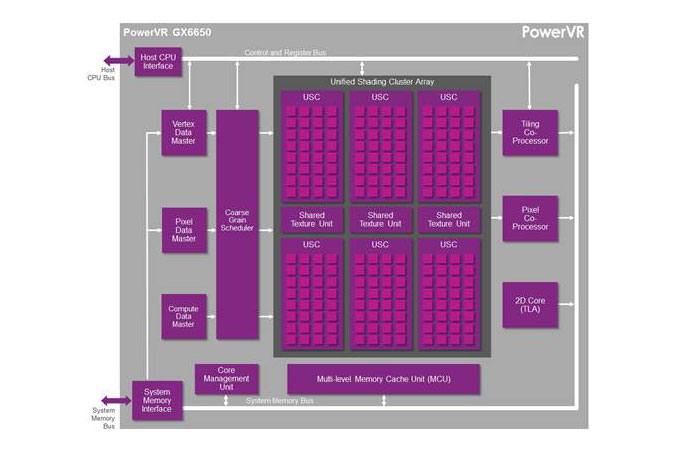Imagination's PowerVR GX6650: Competition for Mobile Kepler
by Anand Lal Shimpi on February 24, 2014 3:27 AM EST
Ryan touched on this in his excellent deep dive on Imagination's PowerVR Series 6XT GPU architecture earlier today, but I wanted to specifically call out the new high-end from IMG that was announced back in January. Pictured above is a high-level block diagram of the new PowerVR GX6650, this is IMG's answer to NVIDIA's mobile Kepler/Tegra K1.
Below I've included a modified version of Ryan's comparison table from his architecture piece:
| GPU Specification Comparison | |||||||
| NVIDIA K1 | Imagination PowerVR GX6650 | Imagination PowerVR G6430 | Imagination PowerVR G6230 | ||||
| FP32 ALUs | 192 | 192 | 128 | 64 | |||
| FP32 FLOPs | 384 | 384 | 256 | 128 | |||
| Pixels/Clock (ROPs) | 4 | 12 | 8 | 4 | |||
| Texels/Clock | 8 | 12 | 8 | 4 | |||
| GFLOPS @ 300MHz | 115.2 GFLOPS | 115.2 GFLOPS | 76.8 GFLOPS | 38.4 GFLOPS | |||
| Architecture | Kepler | Rogue (Series 6XT) | Rogue (Series 6) | Rogue (Series 6) | |||
I tossed in the Series 6 PowerVR G6430 as a comparison point. The G6430 is the GPU in the iPad Air/iPad mini with Retina Display/iPhone 5s. If Apple decides to go all out with a GPU upgrade on its next-generation iPad Air (A8/A8X silicon perhaps?), the GX6650 would likely be the IP to use.










16 Comments
View All Comments
blanarahul - Monday, February 24, 2014 - link
Nvidia should have launched Tegra M1 instead of Tegra K1 + 750 (Ti).darkich - Monday, February 24, 2014 - link
Yeah, it's superior to the mobile Kepler..at this level, mobile based architecture is still better than downscaled performance based architecture.The Maxwell could be the jack of all trades though.
vladz - Monday, February 24, 2014 - link
Well Maxwell will do just the opposite and upscale from mobile solution to desktop so will probably make Nvidia no 1 in mobile space too but Tegra K1 is still a big improvement and equal or almost equal to the competition.Kevin G - Monday, February 24, 2014 - link
The problem is that nVidia has had plans to go to a unified shader architecture in ultra mobile for while now. I believe their first attempts were with a Fermi based design but that didn't pan out so it was cancelled in favor of the existing separate pixel and vertex shader designs (though with some tweaks). Kepler is the first generation to scale down, mainly due to its ability to perform at far lower clock speeds (and thus voltages) than Fermi could.Maxwell will certainly be more ideal in mobile but it likely wasn't ready for inclusion in their next mobile SoC. You go to war with the army you have, not the army you want. Not showing up to the fight isn't an option.
Mondozai - Monday, February 24, 2014 - link
Remember the time when "everyone" agreed that Nvidia's Tegra K1 was going to be invincible if not as a total SoC then at least as a GPU?Well, it seems like the Tegra business is going to take a nosedive once again. Their primary advantage has melted away and their SoC *still* doesn't have an integrated LTE solution.
grahaman27 - Monday, February 24, 2014 - link
Well I think full open gl 4.4 support is still a clear advantage to nvidia, along with recognized support from the gaming industry. And if I were to guess, nvidia probably has the price advantage as well, their chips are usually lower cost.dragonsqrrl - Monday, February 24, 2014 - link
... actually I don't really remember that. I remember people like you saying K1 would be obsolete by the time it came to market, even though by Ryan Smith's own estimates the 6XT series won't come to market before 2015, likely 2H 2015.dragonsqrrl - Monday, February 24, 2014 - link
In which case it would probably be more accurate to call the 6XT series competition for the Tegra variant of Maxwell, than the K1.winterspan - Monday, February 24, 2014 - link
I have hope for mobile Kepler, but after so many disappointing over-hyped releases (in large part because of their perpetual use of the non-unified shader/DirectX 9-level architecture .. well and low memory bandwidth) It is hard not to be negative.fteoath64 - Tuesday, February 25, 2014 - link
I beg to defer. This time NV has cleared carrier certification on I500 modem so the time lag is no longer an issue. They have K1 on silicon and in Lenovo's product so the chip is in production although the quantities depend on the number of customers they can get. M1 is so close, it is not even funny but they do not need to use that as yet!. So they have T4, K1 and potentially M1 to use. All depending on the market direction. This situation has NEVER arisen whatsoever. So it is the reverse of the old dilemma which is a good thing.Remember M1 is going to be mobile efficient using 128 cores to do what 192 cores could do but 90% of it, so per core efficiency is up. Based on how they would want to structure the cores for mobile, they have flexible room to move many ways including tweaking clock speed like in desktop GPU cards.
Imagine, if Intel has this advantage, they would have conquered the whole mobile market in 2 years flat. But alas, Intel does not do ARM!.
NV is NV and not Intel. NV sure took more than 3 years already to have their arm 64bit chip finished. Not there yet ?!. At that rate, the Denver chip would look like a desktop part!. {AMD's arm division would be laughing ...}